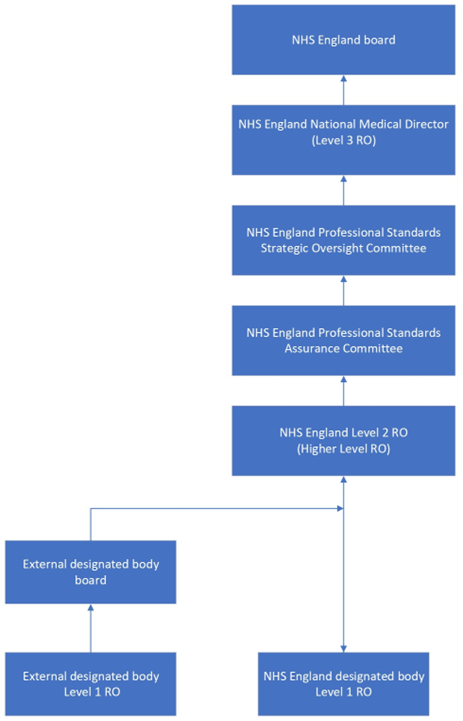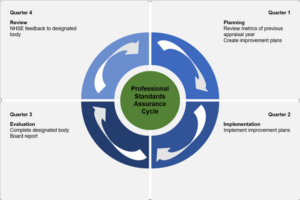Key parameters to assure the NHS England national responsible officer, and in turn the NHS England Board, that relevant statutory obligations are being met and quality improvements supported, as well as other key aspects for NHS England to enhance patient care though high professional standards.
Background and context
The responsible officer in each designated body in England has a duty to comply with the Medical Profession (Responsible Officers) Regulations 2010 (amended 2013) (‘the regulations’) plus a responsibility to undertake continuous quality improvement in the processes associated with these, to enhance patient care. The regulations require the designated body to provide resources to support the responsible officer’s statutory function.
The original Framework of quality assurance (FQA) for responsible officers and revalidation was first published in April 2014 to support implementation of and compliance with the regulations and assure the Secretary of State for Health that these were being enacted. It comprises the main FQA document and seven annexes:
- FQA Annex A: Core standards
- FQA Annex B: Quarterly report
- FQA Annex C: Annual organisational audit (AOA)
- FQA Annex: D&E Annual Board report and statement of compliance
- FQA Annex F: Independent verification
- FQA Annex G: Benchmarking, calibration and checking consistency.
In 2019 a review of the annual organisational audit, Board report template and the Statement of compliance led to a slimmed down version of the AOA and a revised Board report template, which was combined with the Statement of compliance for efficiency and simplicity.
Following the pandemic, an annual Board report, modified to support reporting on appraisal rates, plus a statement of compliance, are the current mainstay of annual reporting. Independent verification and networking to support consistency also continues, supported by the NHS England professional standards teams within regions.
The current context is now different. The implementation phase is complete, and the Department of Health and Social Care no longer requires formal annual assurance of regulatory compliance. Professional standards processes are now embedded as business as usual with increasing focus on continuous improvement and turning compliance into commitment. NHS England is in a phase of transformational change. Finally, the role of other regulatory bodies to assure governance is under discussion. These factors have triggered a review of NHS England routine assurance processes, to develop a revised approach appropriate to the current context.
The original published FQA remains a valid reference, for example, for an organisation newly identified as a designated body, or a designated body for which concerns about compliance with regulations have arisen. However, the new context affects the depth and extent to which NHS England is required to assure these processes within designated bodies. At the same time, NHS England has an important leadership function in respect of the regulations, and of professional standards more widely. The revised framework described in this paper is therefore renamed as the NHS England framework for quality assurance and improvement (FQAI). This sets it in both the context of assurance and of improvement – the latter being increasingly important in professional standards work.
This paper therefore sits as a development of, not a replacement for, the original FQA. The main body of the paper sets out a description of the framework and associated processes. The annexes set out details of the reporting and metrics to support the processes. In keeping with the increasing quality improvement focus, these may be adjusted over time, so it is important to review the current version of these online.
Assurance and improvement at different levels
Level 1
The responsible officer in each designated body external to NHS England and each NHS England level 1 responsible officer has a duty under the regulations to assure and improve their professional standards function for doctors with whom they hold a prescribed connection.
External body responsible officers will primarily report to their Board (or equivalent governing body), providing affirmation of this to their NHS England level 2 responsible officer. NHS England level 1 responsible officers will report directly to their level 2 responsible officer.
This document focuses on assurance and improvement of professional standards processes for doctors outside the training environment. Assurance and improvement of professional standards processes by postgraduate deans following the integration between NHS England and Health Education England are yet to be confirmed but will continue to be coordinated via their national professional lead for now and reported to Professional Standards Assurance Committee directly or via regions as decided in due course.
Level 2 (regional)
NHS England tier 2 (regional) responsible officers and their teams are pivotal in the assurance and improvement of professional standards in England. Their roles can be summarised as follows:
- A regulatory duty to assure and improve their professional standards function for doctors with whom they hold a prescribed connection. This is the same core duty as level 1 responsible officers, and, again, Annex A provides a suitable template for this information. Using this template, the level 2 responsible officer will report to the NHS England senior responsible owner (SRO) for professional standards in their role as chair of the NHS England Professional Standards Assurance Committee (PSAC).
In addition, the level 2 responsible officer and their team have additional responsibility to:
- Confirm assurance and improvement by designated bodies and NHS England level 1 teams in their region.
- Support and advise their connected responsible officers in the discharge of their regulatory responsibilities, including supporting networking activities to promote compliance and consistency.
This will follow the format set out in Annex B, which will be reported to the SRO via PSAC in the same way as Annex A.
Level 3 (national)
The NHS England SRO will, as chair of PSAC:
- receive, collate and review the assurance information from NHS England level 2 teams, taking steps to clarify and support where appropriate.
- then prepare an annual report to the NHS England level 3 responsible officer (the NHS England national medical director) as chair of the Professional Standards Strategic Oversight Group (PSSOG), as assurance of compliance across England with the regulations and of the monitoring and leadership of the responsible officers in England. This will follow the format set out in Annex C.
The content of Annexes A, B and C will be updated as appropriate to further developments in the professional standards programme. It will therefore be important for those using them to check for the current version online.
Ad hoc reporting
Responsible officers may be required to undertake other checks on the quality assurance of the statutory and other key requirements in these matters from time to time as needed. Triggers for such activities may arise internally or externally (whether from their higher-level responsible officer, another relevant agency, or from other processes such as national reports and incidents.
Regulatory duty and general governance responsibility
Responsible officers at all levels have statutory duties towards their connected doctors underpinned by the regulations. They also have general governance responsibilities towards all doctors in their organisation, including doctors whose prescribed connection is to another responsible officer as high professional standards are integral to quality and governance regardless of statute. Maintaining the same governance approach for all doctors working in the organisation regardless of where their prescribed connections lies should be the standard approach in all organisations. Effective systems are also needed, to share relevant information with the responsible officers of doctors connected elsewhere.
Figure 1: Levels of assurance of responsible officer function in England

Figure 1 is a visual representation of the different levels of assurance and improvement.
The cycle of assurance
As the professional standards function has become business as usual, assurance has steadily developed from a process to confirm compliance with regulations to one of development and continual improvement in this area. It is helpful therefore to view the elements of the FQAI as components of a cycle, not static events. In this way FQAI becomes the basis of an iterative process of quality review and improvement, each year identifying those areas most or least in need of improvement. Figure 2 illustrates this, with the quadrants each approximating to 1 quarter in the annual professional standards year as follows:
Quarter 1 April to June
The designated body reviews the previous year’s metrics and uses the framework of their annual Board report template to assess these against last year’s development plan and create their new improvement plan for the coming year.
Quarter 2 July to September
The designated body undertakes actions to implement their improvement plan.
Quarter 3 October to December
The designated body finalises their annual Board report, which comprises their data compiles in quarter 1 and commentary on the actions identified, with any preliminary data on progress with these and presents this to their Board (or equivalent governing body). The Board approves the Statement of compliance. The final approved Board report and Statement of compliance are then submitted to the level 2 responsible officer by the end of this quarter.
Quarter 4 January to March
NHS England professional standards teams review the submitted Board reports and statements of compliance from their designated bodies and use these to compile their upward assurance report to the Professional Standards Assurance Committee (PSAC) and, via PSAC, the Professional Standards Strategic Oversight Group. They also provide feedback and support to the responsible officer in designated bodies where their reporting identifies areas in need of attention.
Figure 2: The cycle of assurance

Figure 2 shows the annual cycle of the framework of quality assurance and improvement.
Publication reference: PRN00816

